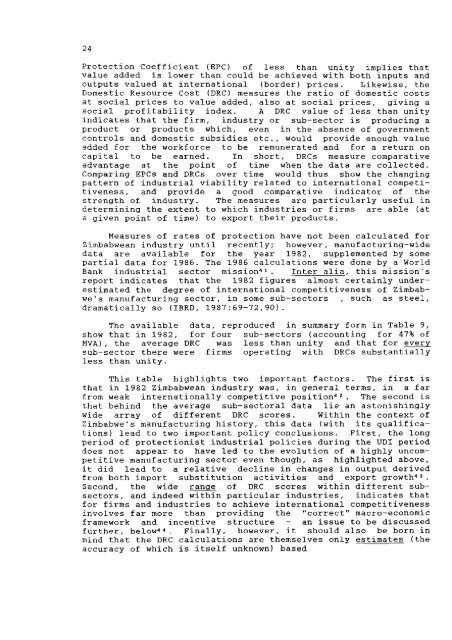Zimbabwe - Overseas Development Institute
Zimbabwe - Overseas Development Institute
Zimbabwe - Overseas Development Institute
Create successful ePaper yourself
Turn your PDF publications into a flip-book with our unique Google optimized e-Paper software.
P r o t e c t i o n C o e f f i c i e n t (EPC) of l e s s than u n i t y implies that<br />
value added i s lower than could be achieved with both inputs and<br />
outputs valued at i n t e r n a t i o n a l (border) p r i c e s . Lil^ewise, the<br />
Domestic Resource Cost (DRC) measures the r a t i o of domestic costs<br />
at s o c i a l p r i c e s to value added, also at s o c i a l p r i c e s , g i v i n g a<br />
s o c i a l p r o f i t a b i l i t y index. A DRC value of l e s s than u n i t y<br />
i n d i c a t e s that the f i r m , i n d u s t r y or sub-sector i s producing a<br />
product or products which, even i n the absence of government<br />
c o n t r o l s and domestic subsidies etc., would provide enough value<br />
added f o r the worltforce to be remunerated and for a return on<br />
c a p i t a l to be earned. In short, DRCs measure comparative<br />
advantage at the point of time when the data are c o l l e c t e d .<br />
Comparing EPCs and DRCs over time would thus show the changing<br />
pattern of i n d u s t r i a l v i a b i l i t y r e l a t e d to i n t e r n a t i o n a l competitiveness,<br />
and provide a good comparative i n d i c a t o r of the<br />
strength of i n d u s t r y . The measures are p a r t i c u l a r l y u s e f u l i n<br />
determining the extent to which i n d u s t r i e s or firms are able (at<br />
a given point of time) to export t h e i r products.<br />
Measures of rates of p r o t e c t i o n have not been c a l c u l a t e d for<br />
<strong>Zimbabwe</strong>an i n d u s t r y u n t i l r e c e n t l y ; however, manufacturing-wide<br />
data are a v a i l a b l e f o r the year 1982, supplemented by some<br />
p a r t i a l data f o r 1986. The 1986 c a l c u l a t i o n s were done by a World<br />
Banl^ i n d u s t r i a l sector mission"'. Inter a l i a , t h i s mission's<br />
report i n d i c a t e s that the 1982 f i g u r e s almost c e r t a i n l y underestimated<br />
the degree of i n t e r n a t i o n a l competitiveness of <strong>Zimbabwe</strong>'s<br />
manufacturing sector, i n some sub-sectors , such as s t e e l ,<br />
d r a m a t i c a l l y so (IBRD, 1987:69-72,90).<br />
The a v a i l a b l e data, reproduced i n summary form i n Table 9,<br />
show that i n 1982, f o r four sub-sectors (accounting for 47% of<br />
MVA), the average DRC was less than u n i t y and that f o r every<br />
sub-sector there were firms operating with DRCs s u b s t a n t i a l l y<br />
l e s s than u n i t y .<br />
This t a b l e h i g h l i g h t s two important f a c t o r s . The f i r s t i s<br />
that i n 1982 <strong>Zimbabwe</strong>an i n d u s t r y was, i n general terms, i n a f a r<br />
from weak i n t e r n a t i o n a l l y competitive p o s i t i o n " ^ . The second i s<br />
that behind the average sub-sectoral data l i e an a s t o n i s h i n g l y<br />
wide array of d i f f e r e n t DRC scores. Within the context of<br />
<strong>Zimbabwe</strong>'s manufacturing h i s t o r y , t h i s data (with i t s q u a l i f i c a <br />
tions) lead to two important p o l i c y conclusions. F i r s t , the long<br />
period of p r o t e c t i o n i s t i n d u s t r i a l p o l i c i e s during the UDI period<br />
does not appear to have l e d to the e v o l u t i o n of a h i g h l y uncomp<br />
e t i t i v e manufacturing sector even though, as h i g h l i g h t e d above,<br />
i t d i d lead to a r e l a t i v e d e c l i n e i n changes i n output derived<br />
from both import s u b s t i t u t i o n a c t i v i t i e s and export growth"'.<br />
Second, the wide range of DRC scores w i t h i n d i f f e r e n t subsectors,<br />
and indeed w i t h i n p a r t i c u l a r i n d u s t r i e s , i n d i c a t e s that<br />
f o r firms and i n d u s t r i e s to achieve i n t e r n a t i o n a l competitiveness<br />
involves f a r more than p r o v i d i n g the " c o r r e c t " macro-economic<br />
framework and i n c e n t i v e s t r u c t u r e - an issue to be discussed<br />
f u r t h e r , below"". F i n a l l y , however, i t should also be born i n<br />
mind that the DRC c a l c u l a t i o n s are themselves only estimates (the<br />
accuracy of which i s i t s e l f unknown) based
















